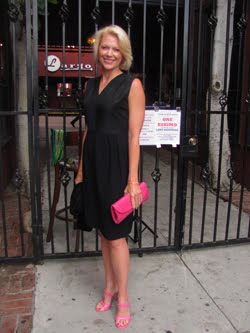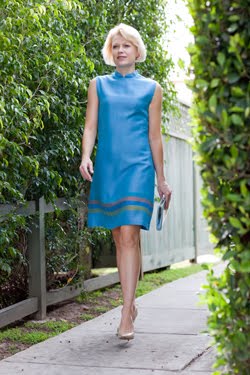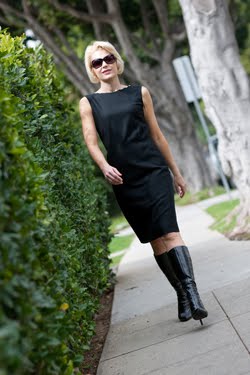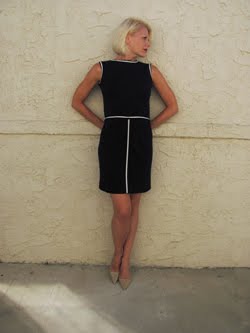girl Friday noun
A female assistant (as in an office) entrusted with a wide variety of tasks.
Though the dictionary may define a "girl Friday" in this way, it hardly describes Hildegard "Hildy" Johnson in the 1940 film His Girl Friday. Played by Rosalind Russell, the character is exceptional in that she is a female reporter at a time when this is very rare, and proves herself to be the most talented of her colleagues. She's also ambitious--in fact, her ex-husband/editor (Cary Grant) uses her drive 1) to get a great story for his paper, and 2) keep the great love of his life. His Girl Friday is very modern, a "curious and complex romantic comedy in which love is expressed through work and work is expressed as love." It may be considered a screwball comedy, but it is groundbreaking in many ways including a career woman's wardrobe that has been influential since the time the film premiered.
To give some context to how bold the role of Hildy Johnson was, consider these facts. In 1940, the population of the United States was 132.2 million. Of this, 13 million women - only a quarter of women over the age of 14 - worked outside the home. Out of every 10 of these women, 3 were in clerical or sales work, 2 worked in factories, 2 were in domestic service, and 1 was a service worker. Only 1 of the 10 was considered a professional, and this usually meant being a teacher or nurse. Hildy is a reporter, and we see all too clearly that she is a woman working in a man's world.
Ben Hecht and Charles MacArthur, former Chicago reporters who became brilliant playwrights and screenwriters, adapted their hit 1928 Broadway play The Front Page for His Girl Friday. Originally written for two male leads, it was director Howard Hawks who could hear something in the dialogue that made him think it would be great coming from a woman. This is not a surprise. Hawks is famous for featuring strong women in his work, so much so that these characters are now known as "Hawksian women." Lauren Bacall is perhaps the best known for her roles in To Have and Have Not (1942) and The Big Sleep (1944), but Rosalind Russell really helped set the standard with His Girl Friday.
Though Russell would spend much of her career playing professional women, she was not Hawks' first choice to play Hildy. In fact, she wasn't his second, third, fourth, or even fifth. She later joked she was "everyone's fifteenth choice" for the role. Irene Dunne had been the front-runner considering her successful pairing with both Cary Grant and Ralph Bellamy in The Awful Truth (1937). Jean Arthur, who starred with Grant in the Hawks movie Only Angels Have Wings (1939), passed on the part so strongly she was suspended by the studio. Others who were considered included Ginger Rogers, Claudette Colbert, Katharine Hepburn, and Margaret Sullavan. Each one refused. Unfortunately, Russell discovered all of this in a New York Times article that reported how Hawks had approached "every important actress in Hollywood" before being "stuck" with her. She confronted the director with the story and he ended the meeting by "instructing her to go to wardrobe and order a sharp-looking striped suit." That suit, and the rest of her wardrobe in His Girl Friday, became iconic courtesy of Robert ("Bobby") Kalloch.
Known to the world simply as Kalloch, he was head of Columbia's costume design department as of 1932. He was one of many costume designers who had an extensive background in the fashion industry before coming to Hollywood. He started as a student at the New York School of Fine and Applied Arts (now known as Parsons). His connection to the school remained strong--even after entering the world of couture, he returned as a lecturer and became a mentor to future MGM head costume designer Adrian. After school, Kalloch worked as a sketch artist and then graduated to dress designer at the prestigious Lucile couturier. Lucile ended up being a valuable training ground for costume designers. Many studio department heads started there--Howard Greer (Paramount), Travis Banton (Paramount), Vera West (Universal), and of course Kalloch himself. He also worked at Madame Frances and Hattie Carnegie in New York, two more couturiers that were filled with future Hollywood costume designers. Kalloch built a name for himself and became internationally known as the designer for royalty, the social elite, and revue stars.
At the peak of Kalloch's fame, studio head Harry Cohn brought him to Columbia to improve upon the studio's reputation, which was then nicknamed "Poverty Row." While at Columbia, Kalloch made his mark in several films, including The Awful Truth (1937) and Holiday (1938). He also worked on the first film to sweep every major Oscar--It Happened One Night (1934). It is among The Style Essentials here on GlamAmor for the impact of its costume design on fashion in the 1930s as well as today. Kalloch is on this elite list again for his work in His Girl Friday. Though the movie may not have the largest wardrobe in film history, it certainly has one of the most influential.
Costumes were only the start of creating the role of Hildy Johnson. Reflecting the ingenuity and determination of her character, Rosalind never let any of the drama of her hiring distract her from the job at hand. And what a job it was. His Girl Friday is now famous for its rapid-fire dialogue and actors who often overlap as they speak. This had been tried before, including by Hawks in other films, but they set a speed record this time. Actors spoke up to 240 words per minute (our average speaking rate is 100-150). In addition, much of the dialogue was ad-libbed, encouraged by Hawks himself. In a move that sounds like something Hildy might do, Russell went to her brother-in-law--then head of a top advertising agency--and paid $200/week for one of his best copywriters to "sharpen her lines." This went on under the radar for weeks until Grant finally demanded to know her secret. By then the two were good friends, and he was so impressed that he asked for some well-crafted lines of his own.
At the peak of Kalloch's fame, studio head Harry Cohn brought him to Columbia to improve upon the studio's reputation, which was then nicknamed "Poverty Row." While at Columbia, Kalloch made his mark in several films, including The Awful Truth (1937) and Holiday (1938). He also worked on the first film to sweep every major Oscar--It Happened One Night (1934). It is among The Style Essentials here on GlamAmor for the impact of its costume design on fashion in the 1930s as well as today. Kalloch is on this elite list again for his work in His Girl Friday. Though the movie may not have the largest wardrobe in film history, it certainly has one of the most influential.
Costumes were only the start of creating the role of Hildy Johnson. Reflecting the ingenuity and determination of her character, Rosalind never let any of the drama of her hiring distract her from the job at hand. And what a job it was. His Girl Friday is now famous for its rapid-fire dialogue and actors who often overlap as they speak. This had been tried before, including by Hawks in other films, but they set a speed record this time. Actors spoke up to 240 words per minute (our average speaking rate is 100-150). In addition, much of the dialogue was ad-libbed, encouraged by Hawks himself. In a move that sounds like something Hildy might do, Russell went to her brother-in-law--then head of a top advertising agency--and paid $200/week for one of his best copywriters to "sharpen her lines." This went on under the radar for weeks until Grant finally demanded to know her secret. By then the two were good friends, and he was so impressed that he asked for some well-crafted lines of his own.
For all that's wonderful about Cary Grant in this movie, it's really Rosalind Russell who makes His Girl Friday so great. Though she was popular in the 1930s and had success with her supporting role in MGM's The Women a year earlier, it was the role of Hildy Johnson in His Girl Friday that was her breakthrough performance. She (and Hawks) gave us a woman who was not only equal to the men around her, but one who was able to excel. She is admired by her colleagues, which is shown particularly well in the scene where they read her article aloud at the jail. Not only are they impressed by her scoop, but also how well written it is. Russell matched her own character's determination, doing what it took behind the scenes to show her skill and work ethic. She was a role model for women everywhere, including when it came to fashion. The pinstriped skirt suit from His Girl Friday became an instant classic, with versions coming out every decade since 1940. It continues to be an essential today.
His Girl Friday was revolutionary to women when it premiered 76 years ago. What's a bit crazy is how revolutionary it continues to be. Despite the fact that we may soon have the first female president, women still find themselves fighting for equal rights, including equal pay and equal opportunities in the workplace. Thankfully, we have Rosalind Russell and her performance in His Girl Friday as an ongoing source of inspiration.
His Girl Friday was revolutionary to women when it premiered 76 years ago. What's a bit crazy is how revolutionary it continues to be. Despite the fact that we may soon have the first female president, women still find themselves fighting for equal rights, including equal pay and equal opportunities in the workplace. Thankfully, we have Rosalind Russell and her performance in His Girl Friday as an ongoing source of inspiration.
The wardrobe starts with Hildy at her most feminine--
wearing what is reported to be a black and pink striped coat and matching hat
wearing what is reported to be a black and pink striped coat and matching hat
Rosalind was apparently hard to photograph because she had something of a weak jaw line. Makeup artist Fred Phillips "[painted] a sharp, very dark line along the edge of her jaw, blending it toward her neck. Then, hitting her with a high key light, that dark line became a strong shadow below her cheek, giving it a firm, youthful appearance."
The gloves come off (and coat) when Walter makes a deal to keep Hildy on the job--
Kalloch was great at being able to change up a look with his use of layers
Kalloch was great at being able to change up a look with his use of layers
As Hildy returns to reporting, so does her work uniform--
this is the iconic suit that still inspires many versions today
Fabric was rationed in the 1940s--
note how Kalloch makes the most of the fabric and
turns the pinstripe pattern on its side for the suit lapels
Hildy is always at the center of the action,
and the other reporters just try to keep up
A couple that works together
stays together
stays together
Some of Kalloch's legacy from His Girl Friday--
a 1980s pinstripe skirt suit from Thierry Mugler (above)
and a pinstripe skirt suit from Brooks Brothers last year
"Girl Friday." Merriam-Webster Dictionary. Online. October 2016.
Jorgensen, Jay and Donald L. Scoggins. Creating the Illusion: A Fashionable History of Hollywood Costume Designers. Running Press: 2015.
Leese, Elizabeth. Costume Design in the Movies. Dover Publications, Inc., 1991.
McCarthy, Todd. Howard Hawks: The Grey Fox of Hollywood. Grove Press, 1997.
Jorgensen, Jay and Donald L. Scoggins. Creating the Illusion: A Fashionable History of Hollywood Costume Designers. Running Press: 2015.
Leese, Elizabeth. Costume Design in the Movies. Dover Publications, Inc., 1991.
McCarthy, Todd. Howard Hawks: The Grey Fox of Hollywood. Grove Press, 1997.
"Working Women in the 1930s." American Decades. Ed. Judith S. Baughman, et al. Vol. 4: 1930-1939. Detroit: Gale, 2001. U.S. History in Context. Web. 23 October 2016. URL http://ic.galegroup.com/ic/uhic/ReferenceDetailsPage/ReferenceDetailsWindow?query=&prodId=UHIC&displayGroupName=Reference&limiter=&disableHighlighting=true&displayGroups=&sortBy=&zid=&search_within_results=&action=2&catId=&activityType=&documentId=GALE%7CCX3468301237&source=Bookmark&u=sand55832&jsid=ff1c546a17b62d2d1ce4007351b97724
United States. Census Bureau. 1940 and 2010 Censuses. Washington: US Census Bureau. Web. 24 October 2016. https://www.census.gov/newsroom/cspan/1940census/CSPAN_1940slides.pdf
United States. Census Bureau. 1940 and 2010 Censuses. Washington: US Census Bureau. Web. 24 October 2016. https://www.census.gov/newsroom/cspan/1940census/CSPAN_1940slides.pdf




































































































No comments:
Post a Comment